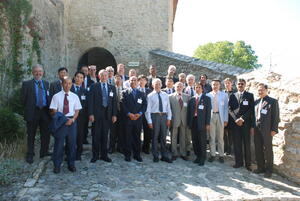Implementing TBMs into the ITER agenda
This week, the second meeting of the Test Blanket Modules (TBM) Program Committee took place in Cadarache. The Committee is charged with the governance of the TBM Program and it serves as an advisory committee for the ITER Council on this matter. It is formed by one governmental representative from each ITER Member and up to three experts per ITER Member from the various national laboratories and universities involved in breeding blanket R&D and in the TBM program. In particular, within its given missions, the TBM Program Committee has the role of discussing and approving all the TBM-related technical and organizational activities including systems selection, program plan and milestones, partnerships and proposals for recovery plans in the case of delay.
In its second meeting, the committee discussed the implementation of the TBM Program into the ITER Research Plan, the planned ITER staff assignments for the TBM Program over the next ten years and the implementation of the TBM Program into the ITER Organization's working structure, including the creation of three port management groups. The plan is to set up one such group per equatorial port which will hold the TBMs. These groups are expected to be the main technical link between ITER Organization and the TBM teams.
During the discussion, we defined the target delivery dates for the Test Blanket Systems to the ITER site. Five out of six TBM are planned for delivery at the end of 2019, the sixth one is expected to arrive by 2022.
The TBM Program Committee further agreed on the revised roles of port masters as requested by the ITER Council. In the new proposal they were limited to technical roles related to integration aspects. The responsibility for the timely delivery and associated commitment has now been transferred to the TBM Leaders: there are two European leaders for the Helium-cooled Lithium Lead TBM and the He-cooled Pebble Beds (Ceramic/Beryllium) TBM; Japan is TBM Leader for the Water-cooled Ceramic Breeder (+Beryllium) TBM; China is the TBM Leader for the He-cooled Ceramic Breeder (+Beryllium) TBM; India is TBM Leader for the Lithium-Lead Ceramic Breeder TBM (LiPb & He, Dual-Coolant type); and the last TBM is not yet committed, but the US, with the help of Korea, is expected to provide all relevant information based on the Dual Coolant (PbLi & He) Lithium-Lead TBM.
Finally, the TBM Program Committee agreed on the ITER Organization proposal to organize a workshop in spring 2010 in order to decide on the need and the possible implementation of countermeasures for reducing the TBM ferromagnetic impacts on the plasma performances. Impacts might occur due to the reduced-activation ferritic/martensitic steel structural material used for all TBMs, which is ferromagnetic. Therefore, there is a TBM-induced magnetic field that creates some ripples in the main ITER magnetic field. As it is not clear what the level of acceptable ripples will be without degrading plasma confinement performances, experiments in existing tokamaks with ITER-relevant plasma scenarios are needed. DIII-D in San Diego is one of these machines and they have accepted to run experiments in mid-November 2009.


